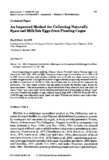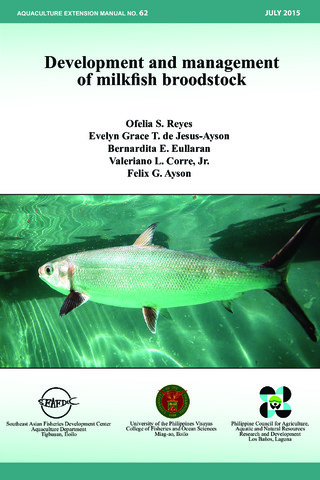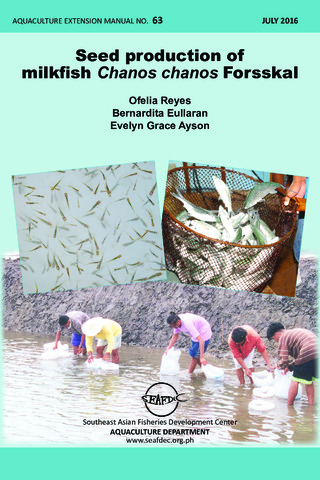An improved method for collecting naturally spawned milkfish eggs from floating cages

Tingnan/
Request this document
Petsa
1988May-akda
Page views
218Metadata
Ipakita ang buong tala ng itemCited times in Scopus
Share
Abstract
Natural spawnings of captive milkfish (Chanos chanos Forsskal) held in floating cages were observed in 1980, 1981, 1983 and 1985. Frequency of spawnings increased from two in 1980 to 41 in 1985. Various collectors and collection methods were tried with only slight improvements in number of eggs collected. Although the number of eggs collected per spawning increased from 900 in 1980 to a maximum of 769 000 in 1985, the numbers were not sufficient for mass-scale fry production. The most urgent problem was egg predators inside the floating cages during the spawning season. This paper presents an improved method of egg collection using fine-mesh net cages ("hapa" nets, 1 mm mesh) which effectively prevented entry of egg predators. Before "hapa" nets were installed the number of eggs collected ranged from 3300 to 668 000. From 330 000 to 2 942 000 eggs were collected by using "hapa" net cages. With the new method mass-scale production of milkfish fry can be achieved.
Suggested Citation
Marte, C. L. (1988). An improved method for collecting naturally spawned milkfish eggs from floating cages. Aquaculture , 71(4), 387-392. https://doi.org/10.1016/0044-8486(88)90208-6
Taxonomic term
Mga koleksyon
- AQD Journal Articles [1222]
Related items
Showing items related by title, author, creator and subject.
-
Annual report 1977
Southeast Asian Fisheries Development Center, Aquaculture Department (Aquaculture Department, Southeast Asian Fisheries Development Center, 1978) -
Development and management of milkfish broodstock
Reyes, Ofelia S.; de Jesus-Ayson, Evelyn Grace T.; Eullaran, Bernadita E.; Corre Jr., Valeriano L.; Ayson, Felix G. (Aquaculture Department, Southeast Asian Fisheries Development Center, 2015)The manual provides developed and refined techniques for collection and transport of spawned eggs and larvae, as well as larval rearing. It also describes the necessary facilities for maintaining milkfish broodstock. Guidelines ... -
Seed production of milkfish Chanos chanos Forsskal
Reyes, Ofelia; Eullaran, Bernadita; Ayson, Evelyn Grace (Aquaculture Department, Southeast Asian Fisheries Development Center, 2016)A 26-page manual describing the site selection, hatchery design, spawning, larval rearing, natural food production, and economic analysis for milkfish.





